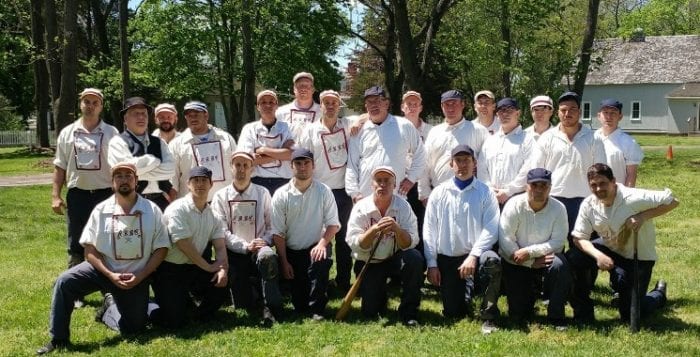Historic baseball swings and hits a homerun in Smithtown

By Marianne Howard
Much intensity erupted when Major League Baseball announced the no-pitch intentional walk rule at the start of the 2017 season. Accordingly, I wondered about the changes of baseball rules and their origins in America. The Smithtown Historical Society is home to the Brooklyn Atlantics, a team of vintage baseball players, those recreate the look and feel of historic baseball. The Atlantics play the game today according to 1864 and 1884 rules. The original Brooklyn Atlantics were the World Champions of baseball for the 1864-1865 season, and champions of their league throughout the 1860s.
So how do these gentlemen play the game? I spoke with Atlantics Captain Frank Van Zant, known to his teammates as Shakespeare, about these rules and how they evolved over time. In 1864, there were no gloves because the homemade baseball was much softer. It was made of one piece of leather which was sewn together. The pitcher stood 45 feet away from the batter, and threw the ball underhand, but with some purposeful zip and intention as to force the batter out. Over the course of 20 years, throughout the 1860s and 1870s, pitchers began to cheat slightly and throw the ball sideways, and eventually quicker and quicker, and then completely overhand. Since pitching this way is faster, it led to the appearance of the first catcher’s glove by the 1880s.
Think about trying to catch a line drive without wearing a glove as a fielder. If you stuck your fingers out, you would most likely break one, so you had to make a decision to force your hand out flat to catch the ball and stick to that, an insistence from today’s Atlantics that those who play this way are truly brave and manly men. In order to avoid injury, balls caught with one bounce in the field were also called as an out. This rule waned after the 1860s, with the fielders considered less manly if they caught the baseball in that fashion. In the early 1860s, balls and strikes did not exist. The calls weren’t “invented” until 1864, and at that point, umpires did not have to call them.
Pitchers could be throwing 40 to 50 pitches per batter Today, a starting pitcher is generally removed after throwing 100 pitches. Therefore, generally speaking, changes in rules over time have been to try to find an acceptable balance between the efforts of the offense and that of the defense.
Want to come down and see the Atlantics in action? Their next home game at the Smithtown Historical Society is on July 22 at 11am. All games are free, open to the public, and the players welcome questions from the audience about the rules and the game.
Marianne Howard is the executive director of the Smithtown Historical Society. For more information on the Society, its events or programs, or becoming a member, please visit smithtownhistorical.org or call 631-265-6768.






